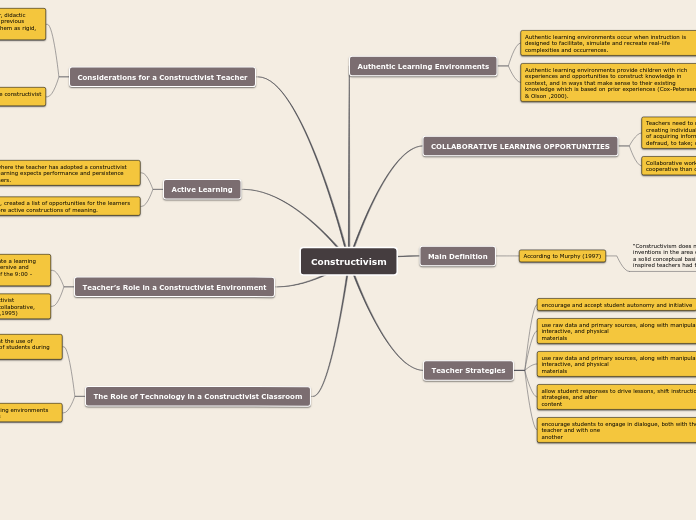
“Knowledge is presented to (learners) in a linear, didactic manner that differs dramatically from children's previous experience outside the school......school stikes them as rigid, uninteresting, and ultimately alienating.”
Key practices that define constructivist
learning environments
personal constructions of reality
simulated authentic learning environments
multiple representations of data
active learning
collaboration
Authentic learning environments occur when instruction is designed to facilitate, simulate and recreate real-life complexities and occurrences.
Authentic learning environments provide children with rich
experiences and opportunities to construct knowledge in context, and in ways that make sense to their existing knowledge which is based on prior experiences (Cox-Petersen & Olson ,2000).
Teachers need to recognize collaboration as a viable method of
creating individual meaning, rather than viewing it as a means of acquiring information from someone else. Cheating is to defraud, to take; collaborating is to build, cooperate.
Collaborative work allows for classrooms to be more cooperative than competitive.
According to Murphy (1997)
“Constructivism does not claim to have made earth-shaking inventions in the area of education; it merely claims to provide a solid conceptual basis for some of the things that, until now, inspired teachers had to do without theoretical foundation.”
encourage and accept student autonomy and initiative
use raw data and primary sources, along with manipulative, interactive, and physical
materials
use raw data and primary sources, along with manipulative, interactive, and physical
materials
allow student responses to drive lessons, shift instructional strategies, and alter
content
encourage students to engage in dialogue, both with the teacher and with one
another
A classroom where the teacher has adopted a constructivist approach to learning expects performance and persistence
from the learners.
Wilson (1997), created a list of opportunities for the learners to develop more active constructions of meaning.
They included simulations, strategy and role-playing games, toolkits and phenomenaria, multimedia learning environments and more.
The role of the constructivist teacher is to create a learning environment as invigorating, interactive, immersive and informative as the life of the student outside of the 9:00 - 3:30 time slot Schwartz (1999)
The learning that is captured within a constructivist environment is pictured as student centered, collaborative, mindson, authentic and action packed (Wilson,1995)
Jonassen & Reeves (1996) determined that the use of computers can enhance cognitive powers of students during thinking, problem solving and learning.
Wilson (1995) defines three types of learning environments that involve technology in varying degrees
Classroom-based learning environments
They are where various
technologies function as tools to support the learning environment.
Computer microworlds
Learners interact mainly with the computer system, this may be effective for home-schoolers, and multi-grade classrooms
Virtual environments
They are mainly open systems that allow for interaction among other participants, resources and representations available virtually